 |
Food |
Hoary
Basil
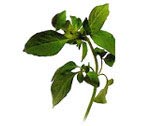 "Maeng-Lak"
in Thai, hoary basil is an annual herbaceous
plant with slightly hairy and pale green leaves, eaten either raw or used
as a flavoring, and containing approximately 0.7% volatile oil. Therapeutic
benefits include the alleviation of cough symptoms, and as diaphoretic
and carminative agents. "Maeng-Lak"
in Thai, hoary basil is an annual herbaceous
plant with slightly hairy and pale green leaves, eaten either raw or used
as a flavoring, and containing approximately 0.7% volatile oil. Therapeutic
benefits include the alleviation of cough symptoms, and as diaphoretic
and carminative agents.
Kaffir
Lime
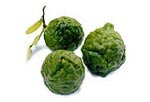 "Ma-krut"
in Thai, the leaves, peels, and juices of the
Kaffir Lime are used as a flavoring in Thai cuisine. The leaves and peel
contain volatile oil. The major therapeutic benefit of the juice is as
an appetizer. "Ma-krut"
in Thai, the leaves, peels, and juices of the
Kaffir Lime are used as a flavoring in Thai cuisine. The leaves and peel
contain volatile oil. The major therapeutic benefit of the juice is as
an appetizer.
Marsh
Mint
 "Sa-ra-nae"
in Thai, the fresh leaves of this herbaceous
plant are used as a flavoring and eaten raw in Thai cuisine. Volatile
oil contents give the plant several therapeutic uses, including carminative,
mild antiseptic, local anaesthetic, diaphoretic, and digestant properties. "Sa-ra-nae"
in Thai, the fresh leaves of this herbaceous
plant are used as a flavoring and eaten raw in Thai cuisine. Volatile
oil contents give the plant several therapeutic uses, including carminative,
mild antiseptic, local anaesthetic, diaphoretic, and digestant properties.
Pepper
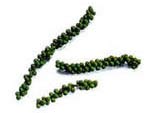 "Phrik-Thai"
in Thai, pepper is a branching, perennial climbing
plant from whose fruiting spikes both white and black pepper are obtained.
Used as a spice and condiment, pepper contains 2 to 4% volatile oil. Therapeutic
uses are as carminative, antipyretic, diaphoretic, and diuretic agents. "Phrik-Thai"
in Thai, pepper is a branching, perennial climbing
plant from whose fruiting spikes both white and black pepper are obtained.
Used as a spice and condiment, pepper contains 2 to 4% volatile oil. Therapeutic
uses are as carminative, antipyretic, diaphoretic, and diuretic agents.
Sacred
Basil
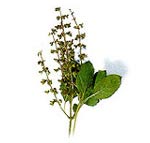 "Ka-phrao"
in Thai, Sacred Basil is an annual herbaceous
plant that resembles Sweet Basil but has narrower and oftentimes reddish-purple
leaves. The fresh leaves, which are used as a flavoring, contain approximately
0.5% volatile oil that exhibits antimicrobial activity, specifically as
a carminative, diaphoretic, expectorant, and stomachic. "Ka-phrao"
in Thai, Sacred Basil is an annual herbaceous
plant that resembles Sweet Basil but has narrower and oftentimes reddish-purple
leaves. The fresh leaves, which are used as a flavoring, contain approximately
0.5% volatile oil that exhibits antimicrobial activity, specifically as
a carminative, diaphoretic, expectorant, and stomachic.
Sweet
basil
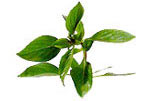 "Ho-ra-pha"
in Thai, Sweet Basil (common basil) is an annual
nerbaceous plant, the fresh leaves of which are either eaten raw or used
as a flavoring in Thai cooking. Volatile oil content varies according
to different varieties. Therapeutic properties are as carminative, diaphoretic,
expectorant, digestant, and stomachic agents. "Ho-ra-pha"
in Thai, Sweet Basil (common basil) is an annual
nerbaceous plant, the fresh leaves of which are either eaten raw or used
as a flavoring in Thai cooking. Volatile oil content varies according
to different varieties. Therapeutic properties are as carminative, diaphoretic,
expectorant, digestant, and stomachic agents.
Top of Page
|
